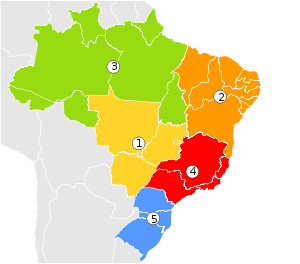
- Image via Wikipedia
Nation leaders yesterday met in New York to discuss strategies to tackle climate change. China made a pledge to reduce greenhouse emissions, but disappointed those who expected more clear-cut figures and detailed plans on how to achieve that. China and the U.S. are responsible for 40% of greenhouse emissions; therefore these two countries are the ones who should be working the hardest to clean up their acts. But, as Obama mentioned, Brazil, one of the world’s largest growing economies, is another important player.
Speaking of Brazil, the ethanol pioneer last week proposed a new bill of law that will restrict the lands permissible for sugarcane farming and processing. If passed, the bill sent to the National Congress by President Luiz Inácio Lula da Silva will prohibit the construction or expansion of sugarcane farms and production plants in any area of native vegetation, or in the Amazon, Pantanal (Brazilian Wetlands) or Upper Paraguay River Basin regions. Coupled with the areas not suitable for sugarcane farming, the bill would effectively make 92.5% of Brazil’s national territory off-limits for sugarcane farming and processing. In addition to the sugarcane zoning mandates, the new bill includes a measure to end the practice of crop burning by 2017 in all areas suitable for mechanized harvesting.
That sounds like a sensible step towards the reduction of the country’s ethanol carbon footprint. Brazil’s sugarcane harvests are used to produce food products as well as sugarcane-based ethanol, a biofuel alternative to gasoline. In Brazil, ethanol consumption surpassed that of gasoline in light vehicles this year. The country has the largest fleet of flex-fuel cars in the world.
The new bill would restrict the expansion of sugarcane production plants to regions that meet the following criteria: areas that do not require full irrigation, as a measure to save resources such as water and energy; and areas with slopes less than 12%, allowing for mechanized harvesting and preventing producers’ clearance of ground by fire. In addition, credit extension policies will favor expansion into underused or degraded pasture land. There’s only one catch: these rules are not applicable to industrial facilities already in operation. These criteria leave 64 million total hectares eligible for sugarcane planting, equivalent to 7.5% of the national land area. Sugarcane crops currently occupy an area of 8.89 million hectares (2008 crop year).
The project, based on the findinds of the National Agro-Ecological Zoning for Sugarcane (ZAE Cana), will be presented as part of Brazil’s platform to curb global climate change and promote environmentally sustainable development at the United Nations’ 15th Conference of the Parties (COP-15) to be held in Copenhagen, Denmark in December 2009.

![Reblog this post [with Zemanta]](https://img.zemanta.com/reblog_e.png?x-id=c87c564c-f4d7-43c5-9291-e4bd2f5de130)





What a dilema, Brazil has done better than any country to reduce dependence on foreign oil, yet they are destroying their environment in the process.